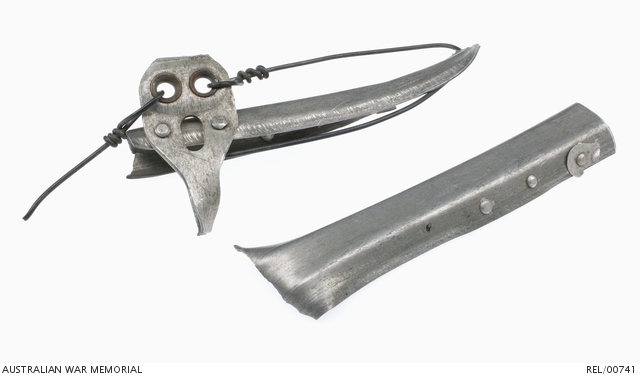| Place | Europe: United Kingdom, England, Greater London, London |
|---|---|
| Accession Number | REL/00741 |
| Collection type | Heraldry |
| Object type | Heraldry |
| Physical description | Aluminium |
| Maker |
Unknown |
| Place made | Germany |
| Date made | 1916 |
| Conflict |
First World War, 1914-1918 |
Two fragments of metal from Zeppelin L31, Potters Bar London 1 October 1916 : Private H A Clapson, 23 Battalion AIF

Two damaged pieces of rib, made of duraluminium (an aluminium alloy), from a German airship.
Two pieces of a damaged German airship collected by Henry Clapson while in London in 1916. It is not certain if he visited the site, which was in north London and about 40 kilometres from the hospital where he was finishing up his convalescence, or whether he was given the pieces by a friend. He later recorded that the pieces came from a 'Zeppelin' that crashed 'close' to where he was a patient. Clapson was a patient at the 3rd London General Hospital at Wandsworth, south of the Thames in London from 30 June to 12 October 1916. Three airships were shot down over England during this period, one in Essex (L33) and two in London, north of the Thames (SL11 and L31).
These pieces probably came from the aluminium framed Zeppelin L31, shot down at Potters Bar in London, rather than the other airship shot down over London - a wooden framed Schutte Lanz airship, the SL11.
The L31 was shot down on 1 October 1916 by Second Lieutenant Wulstan Tempest, 39 Squadron Royal Fling Corps. The crew of L31 were all killed, either by jumping from the flaming Zeppelin or burning to death. They were originally buried at Potters Bar, until their remains were moved to Cannock Chase in Staffordshire in the 1960s.
Pieces of airships, especially Zeppelins, were a very popular souvenir in England. People traveled long distances to view the crash sites and purchase, or scavenge for pieces of the wreckages. At the site of the crash of SL11 pieces of the airship were sold by the Red Cross to raise money for wounded soldiers. They souvenirs proved so popular to visitors of the site at Cuffley that the Red Cross ran out of pieces of the SL11 and began selling pieces of the L31. While some pieces remained as they were found, other pieces of airships were turned items such as pieces of jewellery.
1106 Private Henry Alfred Clapson was almost 20 years old and working as a clerk when he enlisted in the AIF on 9 February 1915. He had previously served with the militia in the 64th Infantry (City of Melbourne) Battalion for nine months. He embarked from Melbourne aboard HMAT Euripides on 10 May 1915 with D Company, 23 Battalion. After training in Egypt Clapson landed at Gallipoli on 4 September and remained there until December, when the Anzac area was evacuated. In March 1916 he embarked with his unit to France. Clapson was wounded on 26 June, with wounds to his left arm and thigh. The battalion had been in reserve, but D Company's headquarters had been heavily shelled, with three men, including Clapson, wounded. After his release from 3 London General Hospital, Clapson spent the remainder of the war in England with the Army Pay Corps. He was promoted to temporary second corporal in February 1917, corporal in March 1918 and to sergeant in November 1918. Clapson left England to return home on 19 January 1919, arriving at Melbourne on 4 March.